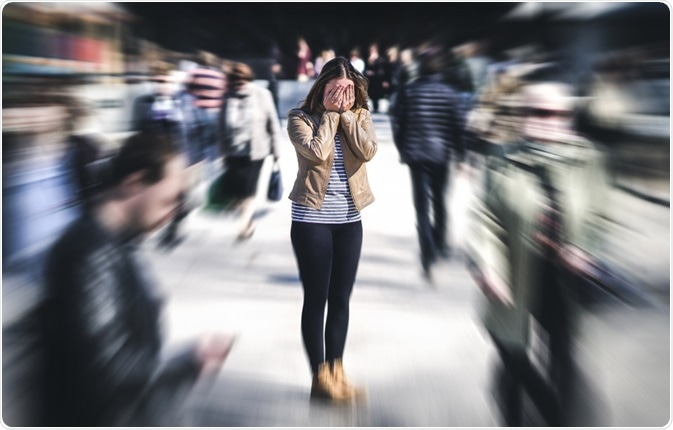Fears are a common part of an individual’s life. However, a phobia is more than a simple fear. It starts and develops into something much bigger when the affected person begins to organise their life around avoiding the feared object – be it an animal, insect, place, situation or other.
 Image Credit: Tero Vesalainen / Shutterstock.com
Image Credit: Tero Vesalainen / Shutterstock.com
Pathophysiology & effects on normal functioning
According to psychiatric parlance phobias are a form of anxiety disorders. The feared object is avoided at all costs and coming face to face with the feared object may lead to increased anxiety and often episodes of panic.
In cases where the phobia is related to an animal or insect such as a snake or a cockroach, it is not faced every day and does not significantly affect the workings of the day-to-day life.
But those with phobias that affect going out in open spaces (agoraphobia) or being in closed spaces like elevators (claustrophobia), normal life can be severely hampered.
Symptoms
Reactions to phobias vary in different sufferers. Symptoms of the anxiety include:
Other symptoms include feeling worried and anxious, feeling tired, poor concentration, irritability and loss of sleep.
Types of phobia
Phobias are classified as simple or complex phobias.
Simple phobias are fears of specific objects, animals, situations or activities including dogs, snakes, spiders, closed spaces, flying, visiting dentists, needles, etc. Some people suffer from a mild anxiety when confronted with the object of their fear and in some people this may manifest as a full blown panic attack and reactions may be severe.
Complex phobias are more difficult to cope with because they are often associated with a deep-rooted fear or anxiety. These include agoraphobia (fear of being in spaces from where escape is difficult like a shopping center, public transport etc.) and social phobia (fear of interacting with people). People with a social phobia have a fear of embarrassing themselves before people.
Epidemiology of phobias
Anxiety disorders come in many varieties and more often than not go undiagnosed. Simple phobias, especially those of objects or events not required to confront in daily lives, are usually unreported.
This could be fear of snakes that a person does not face in his or her day to day life. However, phobias are the most common type of anxiety disorder.
In the UK, an estimated 10 million people have phobias. The condition may affect all sexes, ages and socioeconomic situations.
Simple phobias like fear of needles may begin in childhood and continue till adulthood. Some of these like fear of the dark may emerge at early ages between four and eight (or earlier) and often disappear on their own as the child gets older and usually do not cause problems in adulthood.
Complex phobias usually start later in life. Social phobia for example begins during teenage years and agoraphobia in the late teens to early twenties. These may last several years and if left untreated caused severe debility. Those with social phobias or with agoraphobia may be rendered unable to leave their homes at all.
Treatment of phobias
Phobias, regardless of their complexity and severity, can be successfully treated and cured. Those with simple phobias may be exposed gradually to their object of fear. This is known as desensitisation or self-exposure therapy.
Those with complex phobias however require counselling, psychotherapy, cognitive behavioral therapy and other approaches over a long period of time to be cured of their fears.
Medication is not usually used to treat phobias. Some may need medications for their symptoms of anxiety, panic attacks and depression. Commonly used drugs include antidepressants, tranquilizers and beta blockers.
References
Further Reading